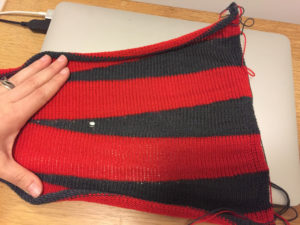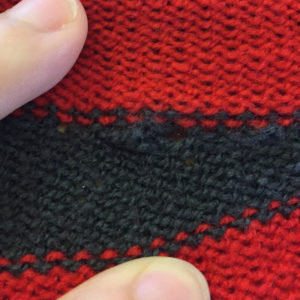I made my first pass at the 4th test piece last night. Even though I know better, I still forgot that yarn of the same weight can knit up differently when dyed different colors; it took me more tries to cast on properly and get the piece started with the black yarn than I’d like to admit.
I managed to drop a stitch in one of the black triangles and pick it up again without noticing (the hole you can see in the middle triangle, on the left). It’s also harder to see when I’ve dropped a stitch on the double bed, what with the fabric going between the beds. I had a much easier time noticing – and fixing – dropped stitches on my Brother KH-930, but I don’t have a ribber bed for it. I haven’t been able to successfully fix a dropped stitch that was done several rows back. When the machine occasionally misbehaves and drops some of the active stitches, I’ve done okay on getting those put back on the needles and maybe hooking up one or two rows back. I think it would be easier if I dropped the front bed and gave myself more room between the beds, but since this pattern also had five needles on the back bed in working position, I didn’t want to try doing that.
This is a pretty terrible picture, but it shows one of the (several) mishaps that happened on the back side of the fabric. These all occurred at the last needle in a short row. From the extra yarn, it looks like it should be a loop of yarn like sometimes happens on the edge of a piece, but that doesn’t actually seem to be what it is. If I examine it closely, it appears that two needles didn’t grab the new yarn (but also didn’t lose the old loop) – sort of like the corresponding pushers were in the rest position (but they weren’t). It happened in three, maybe four, places.
Thinking about it some more, these are potentially spots where stitches were dropped and I had to get the loops back on the needle. I might have gotten the old loops on the needle without noticing that the new yarn was loose. That seems like a more logical explanation than the lock not actuating needles with their corresponding pusher in working position.
The instructions for this test piece were pretty spot on, so that was a nice change of pace. I think they’re still slightly off, but it didn’t cause me any trouble in executing their intent. I’ll keep a closer eye on them for my second attempt with this test piece.


